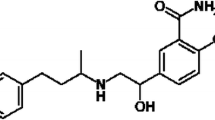Abstract
99mTc-organocation complexes were screened for heart affinity using the isolated perfused rat heart. The 99mTc-I compounds are better extracted by the heart and retained in it than the 99mTc-III compounds. 99mTcCl2(DMPE) +2 shows low uptake (15%) and fast washout, but no impairment of uptake after incubation with human serum albumin(HSA), with a modified preparation, initial uptake is not much better (18%) but washout is clearly diminished. 99mTc(DMPE) +3 is taken up to a greater extent (33%) if administered solely, but when given in conjunction with HSA, uptake decreases to about 4% because of strong affinity of the complex to the protein, but this compound persists well in the tissue. Detergents like tween 80 and dioctylsulphosuccinate are able to cause higher uptake of 99mTc(DMPE) +3 even in the presence of HSA, thus indicating a diminished binding of the compound to the protein. 99mTc(CN-t-butyl) +6 shows very high uptake (80%) by the heart, which is only moderately diminished by addition of HSA (t0 38%), and persists excellently in the myocardium.
Basic features of the compounds such as accumulation in and elimination from the myocardium as well as plasma protein binding and their mutual relationships are well reflected by the isolated heart model.
Similar content being viewed by others
References
Deutsch E, Glavan KA, Sodd VJ, Nishiyama H, Ferguson DL, Lukes SJ (1981) Cationic Tc-99m complexes as potential myocardial imaging complexes. J Nucl Med 22:897–907
Gerundini P, Savi A, Gilardi MC, Margonato A, Vicedomini G, Zecca L, Hirth W, Libson K, Bhatia JC, Facio F, Deutsch E (1986) Evaluation in dogs and humans of three potential technetium-99m myocardial perfusion agents. J Nucl Med 27:409–416
Gokel GW, Widera RP, Weber WP (1975) Phase-transfer Hofmann carbylamin reaction: tert, butyl isocyanid. Org Synth 55:96–99
Goldhaber SZ, Newell JB, Ingwall JS, Pohost GM, Alpert NM, Fossel ET (1983) Effects of reduced coronary flow on Thallium-201 accumulation and release in an in vitro rat heart preparation. Am J Cardiol 51:891–896
Holman BL, Jones AG, Lister-James J, Davison A, Abrams MJ, Kirshenbaum JM, Tumeh SS, English RJ (1984) A new Tc-99-labelled myocardial imaging agent, hexakis(t-butylisonitrile)technitium(I)[Tc-99m TBI]: Initial experience in the human. J Nucl Med 25:1350–1355
Jones AG, Abrams MJ, Davison A, Brodack JW, Toothaker AK, Adelstein SJ, Kassis AI (1984) Biological studies of a new class of technetium complexes: the hexakis(alkylisonitrile)technetium(I) cations. Int J Nucl Med Biol 11:225–234
Kampf G, Knop G, Heise KH, Grossmann B (1987) [99mTc]Technetium(I)hexakis(t-butylisonitrile as a potential perfusion indicator of myocard scintigraphy: further studies in synthesis and uptake in the isolated perfused rat heart. Annual Report of the Department of RI, ZfK 622. (Central Institute of Nuclear Research, Rossendorf) (in press)
Kloster G, Stoecklin G (1982) Determination of the rate-determining step in halofatty acid turnover in the heart. In: Hoefer R, Bergmann H (eds) Radioactive Isotopes in Clinic and Research. 15th Gastein Int Symp: 235–240 Vienna, Egermann
Pendleton DB, Sands H, Gallagher BM, Camin LL (1984) Characterizing potential heart agents with an isolated perfused heart system. J Nucl Med 25:24
Reske SN, Machulla HJ, Sauer W, Huelsmann G, Schienle A, Breull W, Winkler C (1982) Flußdeterminierte myocardiale Aufnahme von (p-123I-Phenyl)Pentadecansäure. Nucl Compact 13:295–299
Syhre R, Seifert S, Muenze R, Kloetzer D, Maeding P, Berger R, Heise KH, Jander R, Kretzschmar M (1984a) Preparation and biological evaluation of 99mTc-Bis(dimethylphosphino)ethane (DMPE) for myocardial imaging. Nucl Compact 15:130–136
Syhre R, Seifert S, Muenze R, Jander R, Kretzschmar M (1984b) Comparing consideration of the biological behaviour of [99mTc(DMPE)2Cl2]+ and [99mTc(DMPE)3]+ in the rat. Nucl Compact 15:240–244
Syhre R, Seifert S, Muenze R, Mohnike W, Schmidt J, Bach H, Muschick P, Rohde E (1985) Myocardial scintigraphy with [99mTc(DMPE)2Cl2]+ in miniature pig. Nucl Compact 16:116–120
Syhre R, Seifert S, Schneider F, Muenze R, Mohnike W, Schmidt J, Gisske H, Bach H (1986) A 99mTc-radiopharmaceutical based on DMPE — suitable for planar scintigraphy and SPECT investigation of the heart. Nucl Compact 17:199–202
Author information
Authors and Affiliations
Rights and permissions
About this article
Cite this article
Kampf, G., Muenze, R., Knop, G. et al. Evaluation of potential heart affine compounds by use of the isolated perfused rat heart. Eur J Nucl Med 13, 410–415 (1987). https://doi.org/10.1007/BF00292494
Received:
Accepted:
Issue Date:
DOI: https://doi.org/10.1007/BF00292494




